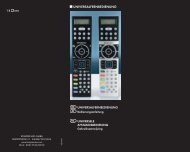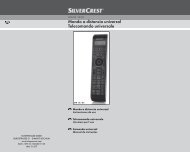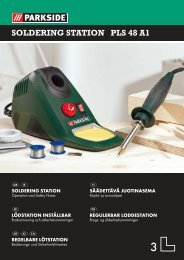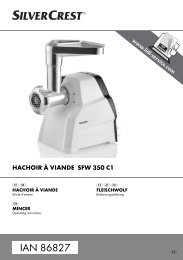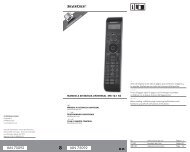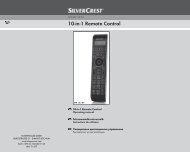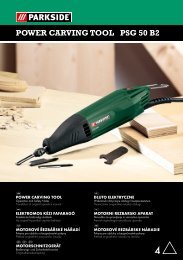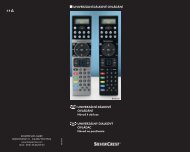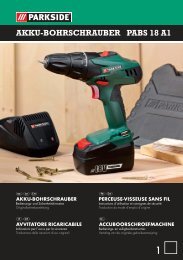SABRE SAW PFS 710 A1 - Kompernass
SABRE SAW PFS 710 A1 - Kompernass
SABRE SAW PFS 710 A1 - Kompernass
Create successful ePaper yourself
Turn your PDF publications into a flip-book with our unique Google optimized e-Paper software.
Introduction / General safety advice for electrical power tools<br />
Blade stroke:<br />
Max. cutting width:<br />
Saw blade mount size: 1<br />
/ 2 “<br />
Protection class:<br />
20 mm<br />
Wood 160 mm<br />
Aluminium 18 mm<br />
Steel 8 mm<br />
Noise and vibration data:<br />
Measured value for sound determined in accordance<br />
with EN 60745. The A-weighted sound level<br />
of the electric power tool is typically:<br />
Sound pressure level: 86 dB(A)<br />
Sound power level: 99 dB(A)<br />
Uncertainty K:<br />
3 dB<br />
Wear ear protection!<br />
Evaluated acceleration, typical:<br />
Hand / arm vibration a h = 6.303 m / s 2<br />
Uncertainty K = 1.5 m / s 2<br />
WARNING! The vibration level given in these<br />
instructions has been measured in accordance with a<br />
standardised measurement procedure specified in<br />
EN 60745 and can be used to compare devices.<br />
Different uses of the device give rise to different vibration<br />
levels and in many cases they may exceed the<br />
values given in these instructions. It is easy to underestimate<br />
the vibration load if the electrical power tool is<br />
used regularly in particular circumstances.<br />
Note: If you wish to make an accurate assessment<br />
of the vibration loads experienced during a particular<br />
period of working, you should also take into account<br />
the intervening periods of time when the device<br />
is switched off or is running but is not actually<br />
in use. This can result in a much lower vibration<br />
load over the whole of the period of working.<br />
General safety advice for<br />
electrical power tools<br />
WARNING! Read all the safety advice<br />
and instructions! Failure to observe the safety<br />
advice and instructions may result in electric shock,<br />
fire and / or serious injury.<br />
Keep all the safety advice and instructions<br />
in a safe place for future reference!<br />
The term “electrical tool” used in the safety advice<br />
refers to electrical tools powered by mains electricity<br />
(by means of a mains lead) and electrical tools powered<br />
by rechargeable batteries (without a mains lead).<br />
1. Workplace safety<br />
a) Keep your working area clean and<br />
well lit. Untidy or poorly lit working areas<br />
can lead to accidents.<br />
b) Do not work with the device<br />
in potentially explosive environments<br />
in which there are<br />
inflammable liquids, gases or dusts.<br />
Electrical power tools create sparks, which can<br />
ignite dusts or fumes.<br />
c) Keep children and other<br />
people away while you are<br />
operating the electrical tool.<br />
Distractions can cause you to lose control of<br />
the device.<br />
2. Electrical safety<br />
a) The mains plug on the device must match<br />
the mains socket. The plug must not<br />
be modified in any way. Do not use<br />
an adapter plug with devices fitted<br />
with a protective earth. Unmodified<br />
plugs and matching sockets reduce the risk of<br />
electric shock.<br />
b) Avoid touching earthed surfaces such<br />
as pipes, radiators, ovens and refrigerators<br />
with any part of your body.<br />
There is an increased risk of electric shock if<br />
your body is earthed.<br />
c) Keep the device away from rain or<br />
moisture. Water entering an electrical device<br />
increases the risk of electric shock.<br />
d) Do not use the mains lead for<br />
any purpose for which it was<br />
not intended, e.g. to carry the<br />
device, to hang up the device or to pull<br />
GB/CY<br />
7



